JavaFX 2.0: Introduction by Example
Copyright 2011 by Carl Dea
This work is subject to copyright. All rights are reserved by the Publisher, whether the whole or part of the material is concerned, specifically the rights of translation, reprinting, reuse of illustrations, recitation, broadcasting, reproduction on microfilms or in any other physical way, and transmission or information storage and retrieval, electronic adaptation, computer software, or by similar or dissimilar methodology now known or hereafter developed. Exempted from this legal reservation are brief excerpts in connection with reviews or scholarly analysis or material supplied specifically for the purpose of being entered and executed on a computer system, for exclusive use by the purchaser of the work. Duplication of this publication or parts thereof is permitted only under the provisions of the Copyright Law of the Publisher's location, in its current version, and permission for use must always be obtained from Springer. Permissions for use may be obtained through RightsLink at the Copyright Clearance Center. Violations are liable to prosecution under the respective Copyright Law.
ISBN-13 (pbk): 978-1-4302-4257-4
ISBN-13 (electronic): 978-1-4302-4258-1
Trademarked names, logos, and images may appear in this book. Rather than use a trademark symbol with every occurrence of a trademarked name, logo, or image we use the names, logos, and images only in an editorial fashion and to the benefit of the trademark owner, with no intention of infringement of the trademark.
The use in this publication of trade names, trademarks, service marks, and similar terms, even if they are not identified as such, is not to be taken as an expression of opinion as to whether or not they are subject to proprietary rights.
While the advice and information in this book are believed to be true and accurate at the date of publication, neither the authors nor the editors nor the publisher can accept any legal responsibility for any errors or omissions that may be made. The publisher makes no warranty, express or implied, with respect to the material contained herein.
President and Publisher: Paul Manning
Lead Editor: Jonathan Gennick
Technical Reviewer: David Coffin
Editorial Board: Steve Anglin, Mark Beckner, Ewan Buckingham, Gary Cornell, Morgan Ertel, Jonathan Gennick,
Jonathan Hassell, Robert Hutchinson, Michelle Lowman, James Markham, Matthew Moodie, Jeff Olson,
Jeffrey Pepper, Douglas Pundick, Ben Renow-Clarke, Dominic Shakeshaft, Gwenan Spearing, Matt Wade,
Tom Welsh
Coordinating Editor: Annie Beck
Copy Editor: Nancy Sixsmith
Compositor: Bytheway Publishing Services
Indexer: BIM Indexing & Proofreading Services
Artist: SPi Global
Cover Designer: Anna Ishchenko
Distributed to the book trade worldwide by Springer Science+Business Media New York, 233 Spring Street, 6th Floor, New York, NY 10013. Phone 1-800-SPRINGER, fax (201) 348-4505, e-mail .
For information on translations, please e-mail .
Apress and friends of ED books may be purchased in bulk for academic, corporate, or promotional use. eBook versions and licenses are also available for most titles. For more information, reference our Special Bulk SaleseBook Licensing web page at www.apress.com/bulk-sales.
Any source code or other supplementary materials referenced by the author in this text is available to readers at www.apress.com. For detailed information about how to locate your book's source code, go to www.apress.com/source-code/.
Contents at a Glance









Contents









About the Author

 Carl P. Dea is currently a Software Engineer working for BCT-LLC on projects with high performance computing (HPC) architectures. He has been developing software for 15 years with many clients from Fortune 500 companies to nonprofit organizations. He has written software ranging from mission-critical applications to web applications. Carl has been using Java since the very beginning and he also is a huge JavaFX enthusiast dating back when it used to be called F3. His passion for software development started when his middle school science teacher had shown him the TRS-80 computer. Carl's current software development interests are rich client applications, game programming, Arduino, mobile phones and tablet computers. When he's not working, he and his wife love to watch their daughters perform at gymnastics meets. Carl lives on the East Coast in Pasadena (aka The Dena), Maryland, USA.
Carl P. Dea is currently a Software Engineer working for BCT-LLC on projects with high performance computing (HPC) architectures. He has been developing software for 15 years with many clients from Fortune 500 companies to nonprofit organizations. He has written software ranging from mission-critical applications to web applications. Carl has been using Java since the very beginning and he also is a huge JavaFX enthusiast dating back when it used to be called F3. His passion for software development started when his middle school science teacher had shown him the TRS-80 computer. Carl's current software development interests are rich client applications, game programming, Arduino, mobile phones and tablet computers. When he's not working, he and his wife love to watch their daughters perform at gymnastics meets. Carl lives on the East Coast in Pasadena (aka The Dena), Maryland, USA.
About the Technical Reviewer
 David Coffin is the author of Expert Oracle and Java Security from Apress. He is an IT analyst working at the Savannah River Site, a large Department of Energy facility. For more than 30 years, David's expertise has been in multiplatform network integration and systems programming. Before coming to the Savannah River Site, he worked for several defense contractors and served as the technical lead for office and network computing at the National Aerospace Plane Joint Program Office at Wright-Patterson Air Force Base in Ohio. As a perpetual student, he has one master's degree and many hours toward another. As a family man, David has raised eight children. He is a triathlete and distance swimmer who competes in the middle of the pack. He is also a classical guitar player, but he's not quitting his day job.
David Coffin is the author of Expert Oracle and Java Security from Apress. He is an IT analyst working at the Savannah River Site, a large Department of Energy facility. For more than 30 years, David's expertise has been in multiplatform network integration and systems programming. Before coming to the Savannah River Site, he worked for several defense contractors and served as the technical lead for office and network computing at the National Aerospace Plane Joint Program Office at Wright-Patterson Air Force Base in Ohio. As a perpetual student, he has one master's degree and many hours toward another. As a family man, David has raised eight children. He is a triathlete and distance swimmer who competes in the middle of the pack. He is also a classical guitar player, but he's not quitting his day job.
Acknowledgments
I would like to thank my wife, Tracey, my daughters, Caitlin and Gillian, for their loving support and sacrifices. A special thanks to my daughter Caitlin, who helped with illustrations and brainstorming fun examples. A big thanks to Jim Weaver for recommending me to this project and being so encouraging. I would also thank Josh Juneau for his advice and guidance throughout this journey.

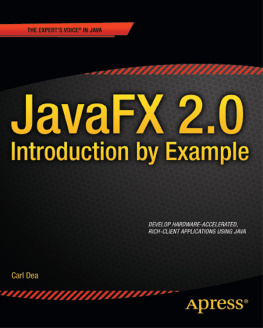
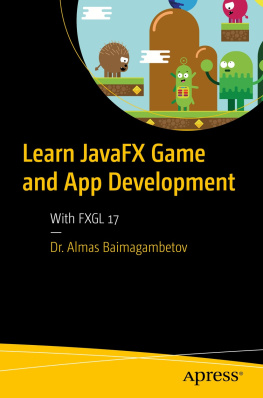
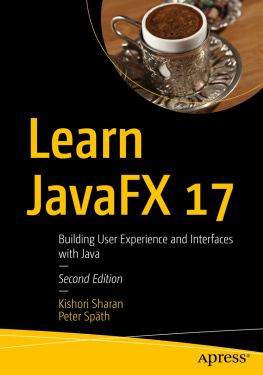


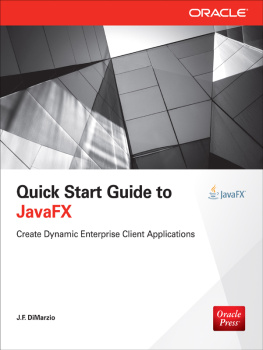
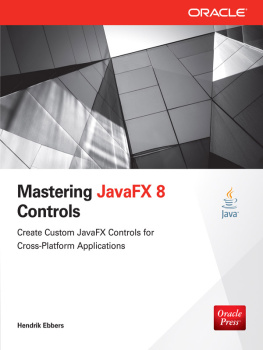
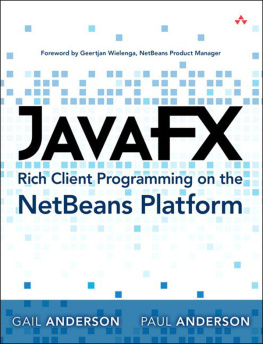
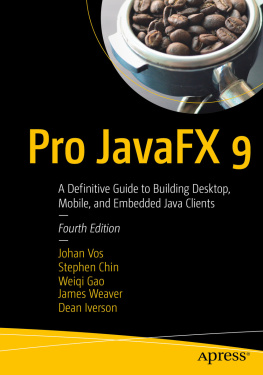
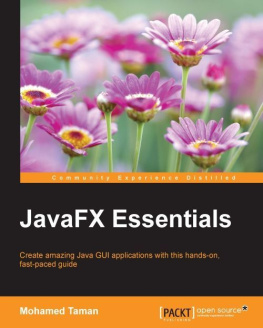





 Carl P. Dea is currently a Software Engineer working for BCT-LLC on projects with high performance computing (HPC) architectures. He has been developing software for 15 years with many clients from Fortune 500 companies to nonprofit organizations. He has written software ranging from mission-critical applications to web applications. Carl has been using Java since the very beginning and he also is a huge JavaFX enthusiast dating back when it used to be called F3. His passion for software development started when his middle school science teacher had shown him the TRS-80 computer. Carl's current software development interests are rich client applications, game programming, Arduino, mobile phones and tablet computers. When he's not working, he and his wife love to watch their daughters perform at gymnastics meets. Carl lives on the East Coast in Pasadena (aka The Dena), Maryland, USA.
Carl P. Dea is currently a Software Engineer working for BCT-LLC on projects with high performance computing (HPC) architectures. He has been developing software for 15 years with many clients from Fortune 500 companies to nonprofit organizations. He has written software ranging from mission-critical applications to web applications. Carl has been using Java since the very beginning and he also is a huge JavaFX enthusiast dating back when it used to be called F3. His passion for software development started when his middle school science teacher had shown him the TRS-80 computer. Carl's current software development interests are rich client applications, game programming, Arduino, mobile phones and tablet computers. When he's not working, he and his wife love to watch their daughters perform at gymnastics meets. Carl lives on the East Coast in Pasadena (aka The Dena), Maryland, USA.